- Home
- Nicholson Baker
The Everlasting Story of Nory
The Everlasting Story of Nory Read online
Acclaim for NICHOLSON BAKER’s
The Everlasting Story of Nory
“Baker is a radiant admirer, a perceptive observer.…[He] has given Nory a quirky and unmistakable flavor of her own.”
—Newsday
“Delightful.… Reading [it] is similar to listening to a series of piano etudes, each with its own theme playfully developed.”
—Time
“The language is wonderful, Nory is a wonder too, but it is the secret life led in Nory’s stories that is the heart of this book.”
—Washington Post Book World
“As well as being great fun to read, The Everlasting Story of Nory makes a sneaky argument about how literature helps us to inhabit our lives, make sense of our impressions, construct our very identities.”
—The Philadelphia Inquirer
“Baker has once again created a poignant portrait of emotional intimacy, this time through the eyes of a child.”
—Bookpage
“A one-of-a-kind creation, filled with laugh-out-loud pleasures and plenty of on-target insights into how children make sense of their world—and enhance that world’s meaning for grownups.”
—The Seattle Times
“Nory is one of the most winning characters that I have met in a novel for some time.”
—The Boston Book Review
NICHOLSON BAKER
The Everlasting Story of Nory
Nicholson Baker was born in 1957 and attended the Eastman School of Music and Haverford College. He has published four novels—The Mezzanine (1988), Room Temperature (1990), Vox (1992), and The Fermata (1994)—and two works of nonfiction, U and I (1991) and The Size of Thoughts (1996). His essays have appeared in The New Yorker, The Atlantic Monthly, The New York Review of Books, Esquire, and The Best American Essays. He lives in Maine with his wife and two children.
Books by NICHOLSON BAKER
The Mezzanine
Room Temperature
U and I
Vox
The Fermata
The Size of Thoughts
The Everlasting Story of Nory
FIRST VINTAGE CONTEMPORARIES EDITION, APRIL 1999
Copyright © 1997 by Nicholson Baker
All rights reserved under International and Pan-American Copyright Conventions. Published in the United States by Vintage Books, a division of Random House, Inc., New York, and simultaneously in Canada by Random House of Canada Limited, Toronto. Originally published in hardcover in the United States by Random House, Inc., New York, in 1998.
Vintage Books, Vintage Contemporaries, and colophon are trademarks of Random House, Inc.
The Library of Congress has cataloged the
Random House edition as follows:
Baker, Nicholson.
The everlasting story of nory / Nicholson Baker.—1st ed.
p. cm.
I. Title.
PS3552.A4325E94 1998
813’.54—dc21 97-23942
eISBN: 978-0-307-80752-6
Author photograph © Jerry Bauer
www.randomhouse.com/vintage
v3.1
For my dear daughter Alice, the informant
Contents
Cover
About the Author
Other Books by This Author
Title Page
Copyright
Dedication
1. What She Liked to Do
2. An Important Building
3. A Story About Beetles
4. Littleguy Had a Sensible Fear of Owls
5. A Slight Problem After Lunch
6. Be Careful About Fluoride
7. Fables in the Car
8. About Debbie
9. A Strange Vegetable
10. The Story of the Fan
11. Feeding the Swans
12. Ladybugs, Butterflies, and a Hurt Thumb
13. Close Calls with Crying
14. Fire Safety Tips
15. The Story of the Deadly Rain
16. Something Needs to Fail
17. A Story About a Girl Named Era and Her Brother
18. A Little About Raccoon
19. A Chinese Monk
20. A Report About the Teeth
21. What You Might Have to Do, Though
22. For Some Reason, People Were Bad to Pamela
23. Pot-stickers Are Not an Easy Thing to Make
24. What You Do and Don’t Remember
25. The Last Straw
26. A Bad Dream That Joe, the Baby-sitter’s Son, Once Had
27. Nory’s Museum
28. Problems with Rabbits
29. Why Not Make a Quilt?
30. The Rest of the Story About the Icy, Freezie Day in Autumn
31. Oatmeal
32. Don’t Forget Your Pencil Case
33. Unexplained Mysteries
34. Things to Rem
35. Break
36. A Bird Problem
37. Pig Bladders
38. More Things That Happened to Pamela
39. Reading Tintin to Her Babies
40. Amnezia and the Dragon
41. In Real Life
42. The Lady Chapel
43. A Talk with Mrs. Thirm
44. Six Extra Brains
45. Nogl Erylalg
46. Some Chandeliers
45. The Bad Sister and the Good Sister
46. Marks
47. Three Forbidden Words
48. Another Bad Thing That Happened to Pamela
49. Word-Fighting
50. The Core of the Friendship
51. The Wind
52. A Story About a Girl Who Meets a Princess
53. Good Result
54. End of Term
1. What She Liked to Do
Eleanor Winslow was a nine-year-old girl from America with straight brown bangs and brown eyes. She was interested in dentistry or being a paper engineer when she grew up. A paper engineer is an artist who designs pop-up books and pop-up greeting cards, which are extremely important to have easily available in stores because they make people happier in their lives. Lately Nory was in a stage of liking to draw pictures of Chinese girls wearing patchwork Chinese robes with their hair up in a little hat, or held on the side with a pin. She told a constant number of stories to herself in the car while they drove to Stately Homes. She also told them to herself in the bathtub or in the mirror. Sometimes she and her friends made up stories together, but that of course depended heavily on the friend. Another thing Nory liked doing was making up new designs of dolls that she wished you could have the opportunity to buy but you can’t and probably never will.
For example, she drew a doll named ‘Riena.’ Riena had straight hair parted on the side and puffy sleeves. She was not stretched out with a teenagery figure or short with a massive rounded head. Her hands and wrists could bend so she could hold a miniature carton of eggs, and every egg would have a realistic crack in the middle. You would help Riena put the egg down on the saucing pan, and shuffle it around, and after a while the egg would break by itself, because it would be filled with a special substance that expanded when you jostled it. A little folded-up rubbery thing that was an egg would goosh out, probably sunny side up, in the pan. Or you could have the second option of scrambled style, or an omelette. Riena had an apron with a pattern of spoons and forks. Sadly she didn’t exist except as a drawing.
Nory was tall for her age, especially in the city of Threll, in England, where she and her mother, her father, and her brother, who was two, were living for a certain amount of time. There were quite a number of girls at her school, the Threll Junior School. She was hoping she would meet a good friend.
2. An Important Building
Threll
Cathedral was the biggest thing in the city, by any means. It was an old cathedral that had a tower on it that had the unique ability to look close to you, and yet be very far away. Airplanes can do that, too. They seem close but aren’t, unless it isn’t your lucky day. Inside the cathedral was almost as beautiful as outside except that there were modern things like wires and plugs that looked as if somebody had made a careless mistake, and modern-day loudspeakers up on the columns looking pretty indistinct. There were also some big tombs carved out of a certain kind of black and red stone that was not precisely frightening but was certainly alarming, because it was so vividly black, and of course there were corpses buried here and there in the walls or in the floor, some of which might be quite mummified. Saint Rufina, a famous woman who had been a very lovely young princess with long black hair who decided to give up her jewelry and become a nun and wear only the roughest clothes, and who died in a terrible way, by being eaten to death by wild dogs that ran through the church in the dead of wintertime, was in a special chapel all to herself, where one arm of her was set aside, that someone had scooped up and saved from the dogs, because everyone had loved her for her kindness and her healing ability. Nearby her chapel was a very tall thin window with pictures of tanks and warships and bombers on it. War pictures didn’t seem like a perfect idea for a subject in stained glass in a famously holy cathedral, but on the other hand if you’re going to have a stained-glass tank or battleship, this was probably the most beautiful tank you would ever find. The caterpillar treads were made of tiny scribs and scrabs of green and blue glass. The window was in honor of some of the people from the city of Threll who had died at war.
Way, way up in a tower above the stone floor of the Cathedral was the Jasperium. It was a kind of a stained-glass window in the form of a dome, right over where the two pieces of the cross met. A cathedral is usually arranged in the shape of a crucifiction, because Jesus died up on the cross. ‘But why,’ Nory wondered sometimes, ‘do they have to concentrate on the awful way he died? Why not have a cathedral in the shape of a G, for God, a squared-off G with an inner courtyard with a wishing well and herbs growing to make tea for the sick, for instance?’ A thousand upon a thousand pieces of green glass were up there in the Jasperium in a little circle—a pretty big circle, actually, but it was little from the distance away you were standing when you looked up at it. When the sun was bright outside, it sent the green light down in a soft green stalk onto the floor of the Cathedral. They had a group of black chairs specially positioned so you could sit in a chair and wait for the green light to come over you like a spotlight on a slug, and supposedly at that moment you could almost think God’s thoughts. You were not really thinking God’s thoughts, of course, but the thoughts God wanted you to think. If you didn’t believe in God, you were thinking what others thought of God, or what they thought God wanted them to think. At least you were thinking the Cathedral’s thoughts in some fashion, which was a pretty worthwhile thing to be able to do on its own.
3. A Story About Beetles
The owners of the Threll Cathedral, who were the Anglican Bishops and Deans, had just spent millions of dollars, or pounds, to clean all the glass in the Jasperium and make sure it wasn’t going to fall down. But while they were doing that, they had discovered that Death Watch Beetles had chewed through the lead that covered the ends of the beams of wood that attached the Jasperium to the tops of the stone columns. So they had to replace some of the wood, but not all. Death Watch Beetles were called that because in former times, when a person was very sick, if his family heard any of these beetles banging their small heads against the wood of a house—chk, chk, chk—it meant the sick person would die soon. Nory, because she wanted to be a dentist, had a specific thought about this, which was: ‘Their teeth must be extraordinarily strong to have chewed through lead. They must be hidden away normally and then fold out when they open their mouths.’ Crocodiles grow twenty-four sets of teeth in their lives and they can perform for two years without food. But Nory severely doubted that the Death Watch Beetle had more than one set of teeth. ‘It must be a difficult way of life up there,’ Nory thought, ‘generation after generation of Beetle, trying to find enough to eat in the old, horrible, chewed-over wood. They must be down to the bare gristle.’ Near the Cathedral was a very good tea shop that had an extremely good chocolate fudge cake. The cake was served with a little cup of whipped cream, by the way.
Nory didn’t like a certain picture in one of the brochures that her parents bought about Threll Cathedral that showed a man wearing a mask putting a metal tube into one of the old pieces of wood under the Jasperium in order to squirt powerful bug-killing foam inside. She had to make up a story about a family of Death Watch Beetles who learned of the approach of a squirt of the poison and packed up their household and made little parachutes out of some candy wrappers one of the bug-killing men had left in the scaffolding and parachuted down, down, down, smuggling through the cool empty air of the inside of the cathedral, swaying, their feelers curled up tight in fear, until they landed in a huge stone land of green light on the cold floor near a little girl with bright eyes and black hair named Mariana.
Mariana was sitting with her eyes closed, waiting to see if she could think the thoughts God wanted her to think. She opened her eyes to see how close the light was to her feet, because she thought that as soon as the light touched her feet she would start to feel the sacred holiness, and she was just creeping her feet a little closer to the light, so that the holiness would get there more quickly, when she thought she noticed something. Yes, she did notice something: four tiny creatures, carefully folding up a chewing-gum wrapper. ‘Oh, who are you?’ she said, bending toward them and letting them hop onto her palm.
‘We’re Death Watch Beetles,’ said one of them. ‘A bad man is squirting our country full of terrible poison.’
‘Oh,’ said Mariana, ‘he isn’t a bad man, I’m sure, he just wants to be sure that the Jasperium doesn’t fall down. You see, when you eat the wood, the wood becomes weaker and weaker, and finally the whole thing would turn to crumbs and fall. You wouldn’t want that to happen to the Cathedral, would you?’
‘Well,’ grudged the Death Watch Beetle, ‘if they’d just explained what the problem was, and given us another piece of wood to live in, we would have left on our own. As it is, look at little Gary, he has gotten sick from chewing on the lead.’ And indeed Mariana saw that little Gary was lying on his back and he did not look at all well. He looked as pale as a bug can look, and near death. Mariana gently put all four beetles in her pencil case and walked out to the forest. She knew where a special fallen tree lay. There was a pool of rainwater in a groove of this tree, and she picked a certain kind of flower as she went, singing a mild song, and crushed the petals in the water. It was a special kind of flower that could cure any kind of lead poisoning, and it was called the Montezuma flower, because it could grow in really hot or very cold places, so that it was a great survivor. Then she opened the pencil case. The three healthy Death Watch Beetles carried Gary, the sick one, out. ‘Wash him in the water,’ said Mariana gently. She was a tall girl with dark brown hair. ‘The potion will help him.’
At first the beetles weren’t sure, and they sniffed the water and tested it with their feelers and that sort of usual behavior. Then gradually they lost their fears and dipped Gary freely in, not head-first but gently, tail-first, and they all went in, one by one, and splashed in the water contentedly. They had spent so many centuries cooped up inside the old Norman beams of the Jasperium that they had forgotten that rainwater could be so clean and pure, and they were overjoyed. Gary sat up in the water and said he felt much better. Then all four of them found a place in a spot of sun to dry their bodies and when they were toasty and warm again, they waved goodbye, and began chewing their mazes in the huge tree trunk. ‘Lovely layers of wood!’ they said. ‘Rings and rings and rings! It’ll be a long time before we chew up this enormous country! Don’t tell anyone you brought us here.’<
br />
‘I won’t,’ laughed Mariana. ‘Good luck!’
‘Thank you, Mariana,’ they called, giving a last happy wave. ‘Bye! Bye! Bye!’
That was a story she had made about them. In real life Nory had never even seen a Death Watch Beetle. But there were definitely some unusual creatures in Threll. The worst one was a huge spider that her mother spotted in the shower curtain while Nory and Littleguy were in the bathtub setting up a store to sell pretend cappuccinos, with bubble foam. Her mother suddenly jumped up with her magazine and hurried them out and called Nory’s father.
‘What is it?’ said Nory, who hadn’t gotten a look because she was shoveled out of the bathroom so quick.
‘Don’t look,’ said Nory’s father. ‘It’s a loathsome Anglo-Saxon bug. It’s huge.’
‘I won’t be disgusted,’ said Nory. ‘I promise, I won’t be.’ She peered in, then instantly wailed out in a misery of disgust and hugged her mother. ‘Oh, awful!’ It was an enormous thing, like a black crab, with the dastardliest hairy legs Nory had ever seen on a spider, and not like a daddy longlegs’s legs, which are quite graceful, but hairy in an ugly thick fearful way. Normally Nory liked all insects, even earwigs, and especially ladybugs, and she did not appreciate any killing, because of the important rule of Do Unto Others, and how would you like it if a huge scrumple of toilet paper came down on you and stole your life away? But this spider in particular was just too hideously hairy-legged to get any empathy from her.
Nory’s father came out.
‘Is it dead?’ they all asked.
Nory’s father said that yes, it was dead.
‘Good,’ said Nory, although immediately she felt a little sad, not to mention embarrassed about shrieking to pieces when she saw it. ‘What did you do with it?’

 House of Holes
House of Holes Checkpoint
Checkpoint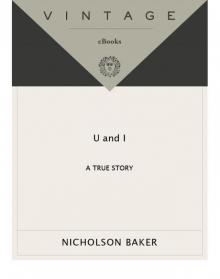 U and I
U and I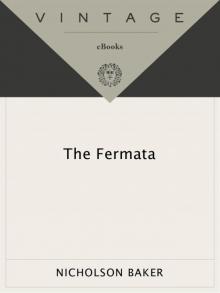 The Fermata
The Fermata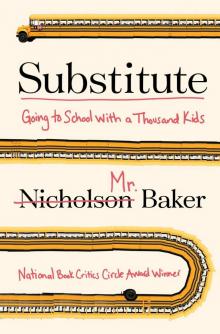 Substitute
Substitute The Size of Thoughts
The Size of Thoughts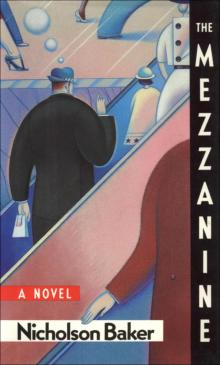 Mezzanine
Mezzanine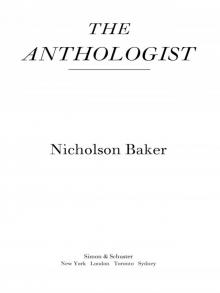 The Anthologist
The Anthologist Traveling Sprinkler
Traveling Sprinkler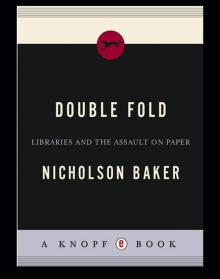 Double Fold
Double Fold The Everlasting Story of Nory
The Everlasting Story of Nory Vox
Vox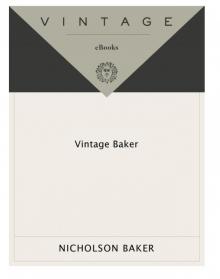 Vintage Baker
Vintage Baker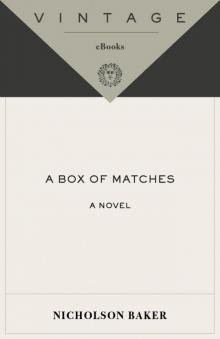 A Box of Matches
A Box of Matches